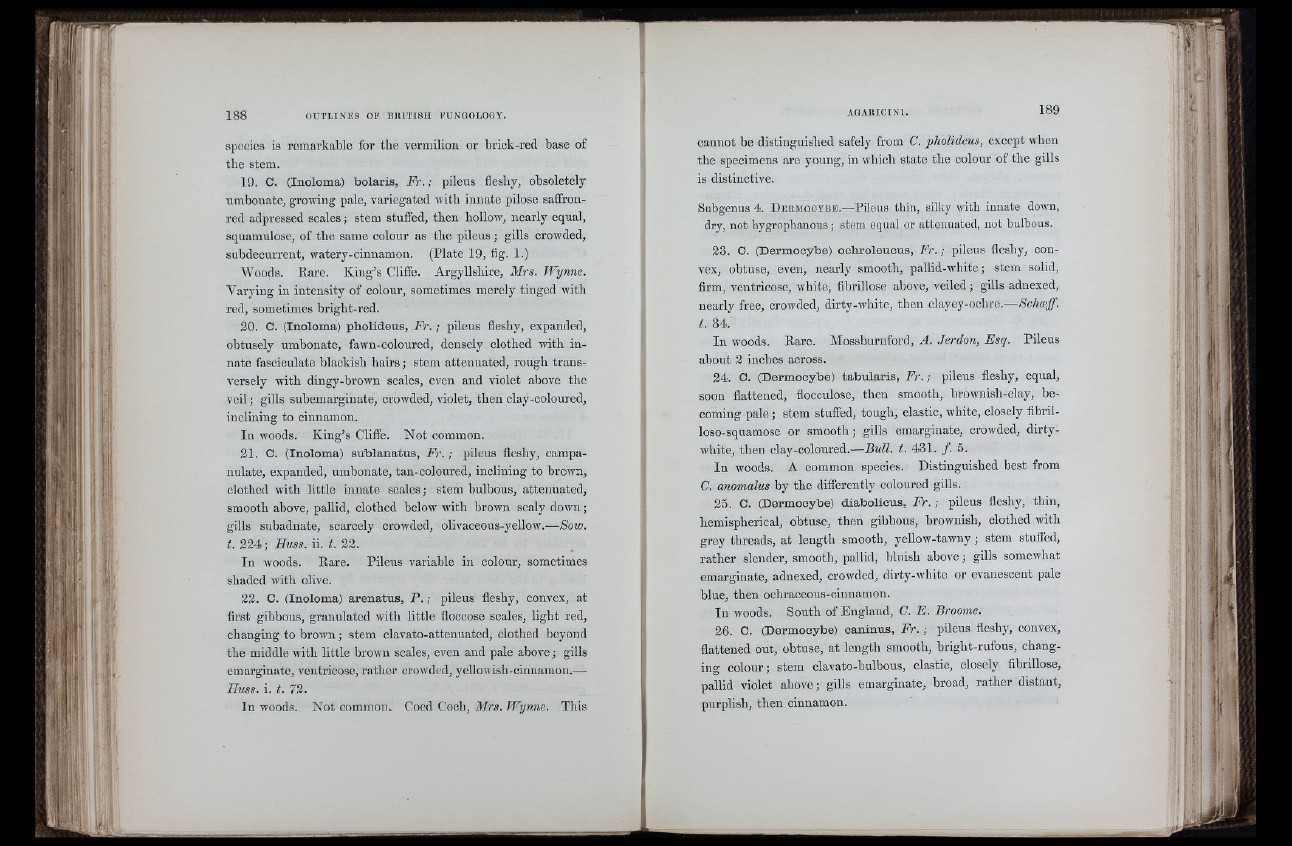
fi
OUT L INE S OF B l l IT ISH FUNGOLOGY.
species is remarkable for the vermilion or brick-red base of
the stem.
19. C. (Inoloma) bolaris, Fr.; pileus fleshy, obsoletely
umbonate, growing pale, variegated with innate pilose saffron-
red adpressed scales; stem stuffed, then hollow', nearly equal,
squamulose, of the same colour as the pileus; gills crowded,
subdecurrent, watery-cinnamon. (Plate 19, fig. 1.)
AVoods. Rare. King’s Cliffe. Argyllshire, Mrs. Wynne.
Varying in intensity of colour, sometimes merely tinged with
red, sometimes bright-red.
30. C. (Inoloma) pholideus, F r .; pileus fleshy, expanded,
obtusely umbonate, fawn-coloured, densely clothed with innate
fasciculate blackish hairs; stem attenuated, rough transversely
with dingy-brown scales, even and violet above the
veil; gills subemarginate, crowded, violet, then clay-coloured,
inclining to cinnamon.
In woods. King’s Cliffe. Not common.
21. C. (Inoloma) sublanatns, Fr. ; pileus fleshy, campanulate,
expanded, umbonate, tan-coloured, inclining to brown,
clothed with little innate scales; stem bulbous, attenuated,
smooth above, pallid, clothed below with brown scaly down;
gills subadnate, scarcely crowded, olivaceous-yellow.—Sow.
t. 224; Fluss. ii. t. 22.
In woods. Rare. Pileus variable in colour, sometimes
shaded with olive.
32. C. (Inoloma) arenatus, P . ; pileus fleshy, convex, at
first gibbons, granulated with little floccose scales, light red,
changing to brown; stem clavato-attenuated, clothed beyond
the middle with little brown scales, even and pale above; gills
emarginate, ventricose, rather crowded, yellowish-cinnamon.—
Huss. i. t. 72.
In woods. Not common. Coed Coch, Mrs. Wynne. This
AGARICINI .
cannot be distinguished safely from C. pholideus, except when
the specimens are young, in which state the colour of the gills
is distinctive.
Subgenus 4. Deemooybe.—Pileus thin, silky with innate down,
dry, not hygrophanous; stem equal or attenuated, not bulbous.
23. C. (Dermocybe) ochrolenous, F r .; pileus fleshy, convex,
obtuse, even, nearly smooth, pallid-white; stem solid,
firm, ventricose, white, fibrillose above, veiled; gills adnexed,
nearly free, crowded, dirty-white, then clayey-ochre.—Schmff.
t. 34.
In woods. Rare. Mossburnford, A. Jerdon, Esq. Pileus
about 3 inches across.
24. C. (Dermoeybe) tabularis, F r .; pileus fleshy, equal,
soon flattened, flocculose, then smooth, hrownish-clay, becoming
pale ; stem stuffed, tough, elastic, white, closely fibrilloso
squamose or smooth; gills emarginate, crowded, dirty-
white, then clay-coloured.—Bull. t. 431. / . 5.
In woods. A common species. Distinguished best from
C. anomalus by the differently coloured gills.
25. C. (Dermocybe) diabolions, F r .; pileus fleshy, thin,
hemispherical, obtuse, then gibbous, brownish, clothed with
grey threads, at length smooth, yellow-tawny; stem stuffed,
rather slender, smooth, pallid, bluish above; gills somewhat
emarginate, adnexed, crowded, dirty-ivhite or evanescent pale
blue, then ochraceous-cinnamon.
In woods. South of England, C. E. Broome.
26. C. (Dermoeybe) oaninns, F r .; pileus fleshy, convex,
flattened out, obtuse, at length smooth, bright-rufous, changing
colour; stem clavato-bulbous, elastic, closely fibrillose,
pallid violet ahove; gills emarginate, broad, rather distant,
purplish, then cinnamon.
J .